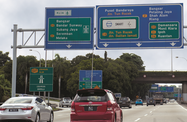The Malaysian aerospace industry is set for substantial growth due to a thriving regional aviation sector and government initiatives focused on increasing specialisation.
Under the National Aerospace Industry Blueprint 2015-30 – Malaysia’s second long-term plan for the sector launched in March of last year – the country aims to become the leading aerospace training and education destination in South-east Asia by 2020 and the top aerospace manufacturing centre in the region by 2025.
Industry blueprint
The economic potential of the plan is highlighted by the substantial growth of Asia-Pacific’s aviation sector – with annual air traffic in the region growing by 7.3% per annum compared to the global average of 5% – and rising demand for parts, technology and services, contributing to the already rapid expansion of earnings and capacity.
In Malaysia’s inaugural plan – the National Aerospace Industry Blueprint 1997-2015 – four pillars were identified as key to the country’s push to become a global aerospace industry player: maintenance, repair and overhaul (MRO); manufacturing; training and education; and systems integration.
The latest blueprint carries over these specialisations and adds another focus for engineering services, calling for greater emphasis on consulting, engineering and analytical services for the global aviation supply chain.
Although the engineering segment requires high levels of investment and technology, the plan envisions strong returns on capital input, estimating that engineering services could generate revenue of RM3.5bn ($854.5m) by 2020 and create 11,500 jobs, with a large number in high-value engineering segments.
Spotlight on MRO
While Malaysia has raised its profile in all four segments laid out in the inaugural blueprint, the greatest progress has been made in the local MRO segment, which has captured 5% of the global market.
Currently, MRO accounts for 55% of total revenue in the Malaysian aerospace industry, followed by the aero-manufacturing segment, which contributes 33%, Jai Shankar, Malaysia’s trade commissioner in Germany, told regional media in April.
Malaysia’s MRO segment is also expected to be one of the main beneficiaries of an increase in new aircraft.
Demand for aircraft over the next 20 years is projected to reach 38,050, with approximately 37% of the new aircraft expected to go to the Asia-Pacific region, according to data from the Malaysian Investment Development Authority (MIDA).
MIDA has estimated that the rise in demand for aircraft in the region could drive earnings in Malaysia’s aerospace industry to RM55.2bn ($13.5bn), almost three times the 2014 level of RM19bn ($4.6bn).
Seeking to capitalise on this growth, Aircraft Propeller Service (APS), a US-based firm that maintains and repairs aircraft propeller components, announced in early May that it would open a new MRO facility at Kuala Lumpur International Airport.
The centre, which will be operational by August, will initially serve subsidiaries of Malaysia Airlines before expanding to the wider aviation market by the second half of 2017.
Targets for expansion
Asia Aerospace City (AAC) – a dedicated industrial hub located on 328,000 sq metres of land at Subang, next to the Sultan Abdul Shah Airport outside of Kuala Lumpur – will be key to expanding Malaysia’s aerospace industry to serve the wider region.
While mainly catering to original equipment manufacturers, AAC – which is being developed by state agency Mara Aerospace & Technologies and set to open in 2018 – will offer space and services to firms at all points along the supply chain.
By 2020, AAC is estimated to be valued at RM1trn ($244bn).
Malaysia is also targeting the avionics segments as an avenue for sector growth. According to Modh Yusoff Sulaiman, president and CEO of the Malaysian Industry-Government Group for High Technology, the country has yet to make major inroads in this area.
“We thought our strength in the electronics industry would spur development in avionics, but currently most involvement in this segment is by multinationals,” he told OBG. “So we are now moving development towards local capacity building via business acquisition, attracting overseas businesses to work with local partners.”
One such international tie-up came a step closer to realisation in mid-February, when UMW Holdings proposed plans to establish an aerospace manufacturing park at Serendah in Selangor to produce fan cases for Rolls Royce’s aircraft engines.
UMW signed a 25-year deal with the UK firm in August last year to manufacture and assemble aerospace engine component products.
Investments in Malaysia’s aerospace sector are already paying off, with exports generating RM4.2bn ($1.03bn) in revenue last year, a 44.7% increase from 2014.
Broadening the base of the industry is also boosting self-sufficiency and curbing imports, with inbound aerospace shipments down 33.5% at RM10bn ($2.4bn) in 2015.
Oxford Business Group is now on Instagram. Follow us here for news and stunning imagery from the more than 30 markets we cover.

